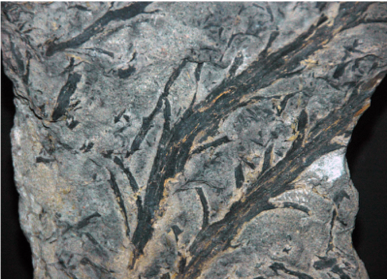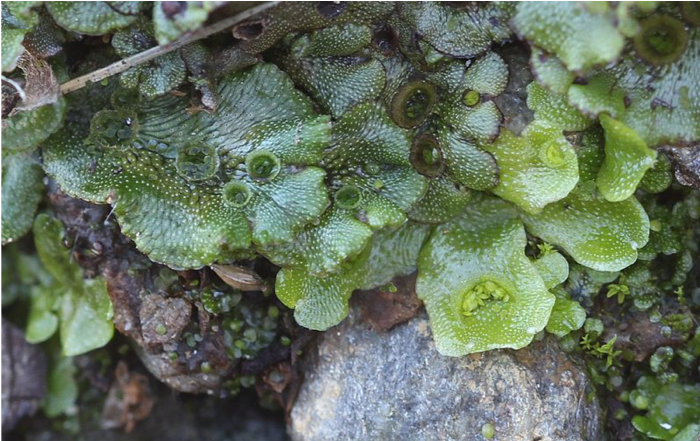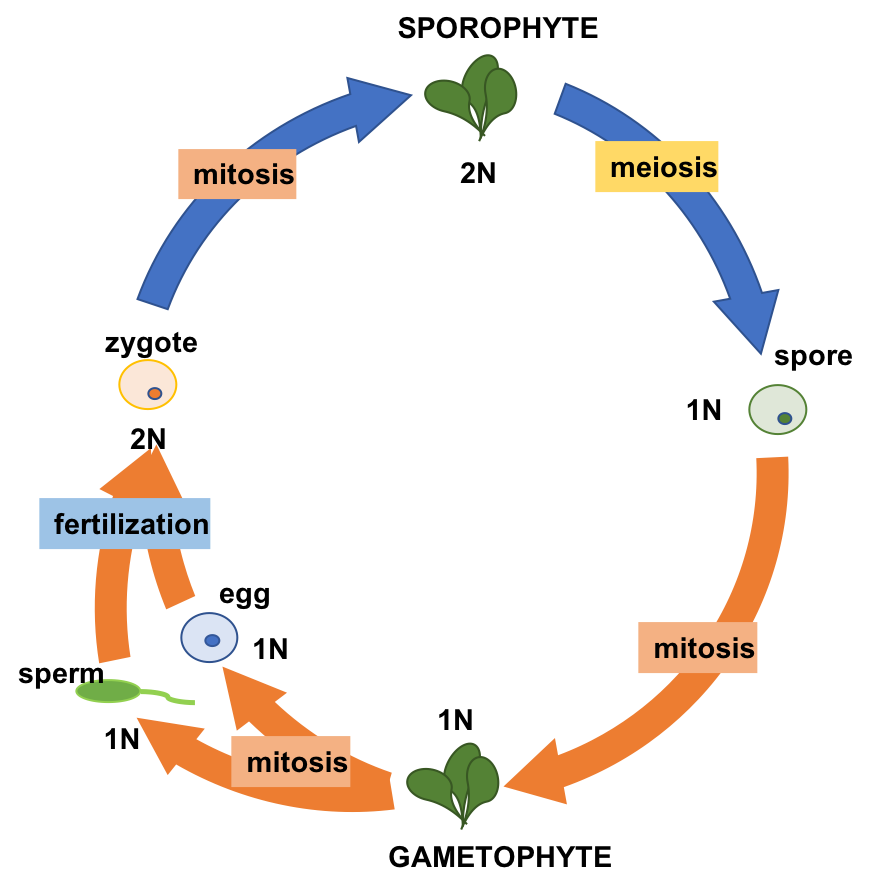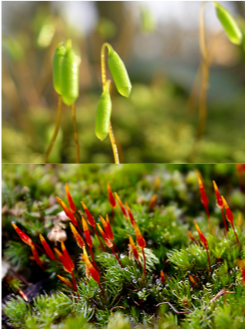24
Learning Goals

By the end of this reading you should be able to
- Discuss the challenges to plant life on land
- Describe common characteristics of all land plants
- Relate specific adaptive features to the unique challenges of life on land
Introduction
Current evolutionary thought holds that all plants—green algae as well as land dwellers—are monophyletic; that is, they are descendants of a single common ancestor. At some point in the evolutionary history of plants, there was a transition from an aquatic environment to the terrestrial one. This transition from water to land imposed severe constraints on plants. Plants had to develop strategies to avoid drying out, to disperse reproductive cells in air, to provide structural support, to exchange gases without water, and as they grew larger to move molecules by bulk flow. While some groups of plants developed adaptations that allowed them to populate even the aridest habitats on Earth, full independence from the water did not happen in all plants. As a group, most seedless plants still require a moist environment for at least some of their physiological functions. Land plants can be separated by the degree of development of their structures, both vascular as well as reproductive, and the variation in their alternation of generations lifecycle.
Plant Adaptations to Life on Land
As organisms adapted to life on land, they had to contend with several challenges in the terrestrial environment. Water has been described as “the stuff of life.” The cell’s interior is a watery soup: in this medium, most small molecules dissolve and diffuse, and the majority of the chemical reactions of metabolism take place. Desiccation, or drying out, is a constant danger for an organism exposed to air. Even when parts of a plant are close to a source of water, the aerial structures are likely to dry out. Water also provides buoyancy to organisms. On land, plants need to develop structural support in a medium that does not give the same lift as water. The organism is also subject to bombardment by mutagenic radiation because air does not filter out ultraviolet rays of sunlight. Additionally, the male gametes must reach the female gametes using new strategies, because swimming is no longer possible. Therefore, both gametes and zygotes must be protected from desiccation. The successful land plants developed strategies to deal with all of these challenges. Not all adaptations appeared at once. Some species never moved very far from the aquatic environment, whereas others went on to conquer the driest environments on Earth.
To balance these survival challenges, life on land offers several advantages. First, sunlight is abundant. Water acts as a filter, altering the spectral quality of light absorbed by the photosynthetic pigment chlorophyll. Second, carbon dioxide is more readily available in the air than in water, since it diffuses faster in air. Third, land plants evolved before land animals; therefore, until dry land was colonized by animals, no predators threatened plant life. This situation changed as animals emerged from the water and fed on the abundant sources of nutrients in the established flora. In turn, plants developed strategies that deterred predation: from spines and thorns to toxic chemicals.

The most successful adaptation solution was the development of new structures that gave plants the advantage when colonizing new and dry environments. Four major adaptations are found in all terrestrial plants: the alternation of generations, a sporangium in which the spores are formed (Fig. 1), a gametangium that produces haploid cells, and apical meristem tissue involved in growth. The evolution of a waxy cuticle (Fig. 2) and a cell wall with lignin also contributed to the success of land plants, although not all land plants have lignin. These adaptations are noticeably lacking in the closely related green algae, further differentiating these two lineages.
Review Question:
Alternation of Generations
Alternation of generations describes a life cycle in which an organism has both haploid and diploid multicellular stages (Fig 3).

Regardless of the size of the gametophyte and/or sporophyte stage, the protection of the embryo is a major requirement for land plants. The vulnerable embryo must be sheltered from desiccation and other environmental hazards. In all land plants, the female gametophyte provides protection and nutrients to the embryo as it develops into the new generation of the sporophyte. This distinguishing feature of land plants, which is not present in green algae, makes all land plants embryophytes.
Review Question:
____________ occurs when gametophytes produce gametes
The zygote undergoes ____________ to become the multicellular ____________
Sporangia in Seedless Plants
The sporophyte of seedless plants is diploid and results from syngamy (fusion) of two gametes. The sporophyte bears the sporangia (singular, sporangium) (Fig. 4): organs that first appeared in the land plants. The term “sporangia” literally means “spore in a vessel,” as it is a reproductive sac that contains spores.

Inside the multicellular sporangia, the diploid sporocytes, or mother cells, produce haploid spores by meiosis. The spores are later released by the sporangia and disperse in the environment. Seedless non-vascular plants produce only one kind of spore and are called homosporous. The gametophyte phase is dominant in these plants. After germinating from a spore, the resulting gametophyte produces both male and female gametangia, usually on the same individual. In contrast, heterosporous plants produce two morphologically different types of spores (Fig. 1). The male spores are called microspores, because of their smaller size, and develop into the male gametophyte; the comparatively larger megaspores develop into the female gametophyte. Heterospory is observed in a few seedless vascular plants and in all seed plants.
The spores of seedless plants are surrounded by thick cell walls containing a tough polymer known as sporopollenin. This complex substance is characterized by long chains of organic molecules related to fatty acids and carotenoids: hence the yellow color of most pollen. Sporopollenin is unusually resistant to chemical and biological degradation. Sporopollenin was once thought to be an innovation of land plants; however, the green algae Coleochaetes forms spores that contain sporopollenin.
Gametangia in Seedless Plants
Gametangia (singular, gametangium) are structures observed on multicellular haploid gametophytes. In the gametangia, germline cells give rise to gametes by mitosis. The male gametangium (antheridium) releases sperm. Many seedless plants produce sperm equipped with flagella that enable them to swim in a moist environment to the archegonia: the female gametangium. The embryo develops inside the archegonium as the sporophyte. Gametangia are prominent in seedless plants but are very rarely found in seed plants.
Other adaptive features
- As plants adapted to dry land and became independent from the constant presence of water in damp habitats, new organs and structures made their appearance.
- Early land plants did not grow more than a few inches off the ground, competing for light on these low mats. By developing a shoot and growing taller, individual plants captured more light.
- Because air offers substantially less support than water, land plants incorporated more rigid molecules in their stems (and later, tree trunks).
- In small plants such as single-celled algae, simple diffusion suffices to distribute water and nutrients throughout the organism. However, for plants to evolve larger forms, the evolution of vascular tissue for the distribution of water and solutes was a prerequisite. The vascular system contains xylem and phloem tissues. Xylem conducts water and minerals absorbed from the soil up to the shoot, while phloem transports food derived from photosynthesis throughout the entire plant.
- A root system evolved to take up water and minerals from the soil and to anchor the increasingly taller shoot in the soil.
- In land plants, a waxy, waterproof cover called a cuticle protects the leaves and stems from desiccation.
- However, the cuticle also prevents the intake of carbon dioxide needed for the synthesis of carbohydrates through photosynthesis. To overcome this, stomata or pores that open and close to regulate the traffic of gases and water vapor appeared in plants as they moved away from moist environments into drier habitats.
- Water filters ultraviolet-B (UVB) light, which is harmful to all organisms, especially those that must absorb light to survive. This filtering does not occur for land plants. This presented an additional challenge to land colonization, which was met by the evolution of biosynthetic pathways for the synthesis of protective flavonoids and other compounds: pigments that absorb UV wavelengths of light and protect the aerial parts of plants from photodynamic damage.
- Plants cannot avoid being eaten by animals. Instead, they synthesize a large range of poisonous secondary metabolites: complex organic molecules such as alkaloids, whose noxious smells and unpleasant taste deter animals. These toxic compounds can also cause severe diseases and even death, thus discouraging predation. In contrast, as plants co-evolved with animals, the development of sweet and nutritious metabolites lured animals into providing valuable assistance in dispersing pollen grains, fruit, or seeds. Plants have been enlisting animals to be their helpers in this way for hundreds of millions of years.
Thinking Question:
Which trait(s) are likely to have evolved first as the ancestors of land plants adapted to more terrestrial environments? Defend your answer.
Summary
Land plants acquired traits that made it possible to colonize land and survive out of the water. All land plants share the following characteristics: alternation of generations, with the haploid plant called a gametophyte, and the diploid plant called a sporophyte; protection of the embryo, formation of haploid spores in a sporangium, the formation of gametes in a gametangium, and an apical meristem. Vascular tissues, roots, leaves, cuticle cover, and a tough outer layer that protects the spores contributed to the adaptation of plants to dry land.
End of Section Review Questions:
Review: Reproductive terminology
1) Match the term with the best description
| 1) Homosporous | A) undergo meiosis to produce haploid spores |
| 2) Microspore | B) producing two different types of spores |
| 3) Sporopollenin | C) polymer found in spore cell walls |
| 4) Sporocytes | D) produce only one type of spore (seedless non-vascular plants) |
| 5) Heterosporous | E) where precursor cells give rise to gametes by mitosis |
| 6) Gametangia | F) develops into the male gametophyte |
Review: Alternation of Generations
3) Which is true about alternation of generations in land plants? (Multiple Answers)
Image Attributions
Figure 1. Image courtesy of James St. John [CC BY 2.0 (https://creativecommons.org/licenses/by/2.0)]
Figure 2. Image courtesy of Avenue [GFDL (http://www.gnu.org/copyleft/fdl.html)]
Figure 3. Image created and provided by D. Jennings
Figure 4. Top Image courtesy of Guido Gerding – Own photograph, URL: Ex :: Natura – Freies Portal für Umweltbildung (Environmental Education), CC BY-SA 3.0, https://commons.wikimedia.org/w/index.php?curid=499406. Bottom Image courtesy of Vaelta at English Wikipedia. [CC BY-SA 3.0 (http://creativecommons.org/licenses/by-sa/3.0/)]

